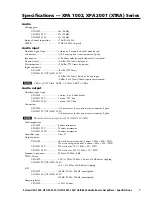
The Technical Stuff
__________________________________________________________
- 12 -
History of the 2-LA-2
The original LA-2A design was the brainchild of James F. Lawrence Jr., who had been a radar operator
in World War II. Following his tour of duty, Lawrence began studying electrical engineering at the
University of Southern California, while also quietly designing sub-miniature telemetry devices and
optical sensors for the military. But his passion was always radio, and he eventually landed a job as a
broadcast engineer at KMGM in Los Angeles, where he soon became frustrated with having to
constantly ride gain to ensure a proper signal. This led to Lawrence’s conception of a device he called
a “leveling amplifier.”
Shortly afterwards, Lawrence started a company called Teletronix, setting up shop in his hometown of
Pasadena, California in 1958. Among the line of broadcast products manufactured by Teletronix were
conversion and transmitter tubes, emergency tone generators, multiplex generators, even full-scale
radio transmitters. Lawrence’s first attempt at building a leveling amplifier resulted in the Teletronix
LA-1, of which around one hundred units were made.
Teletronix LA-1
At the heart of the LA-1 was an electro-optical sensor. This was a small light-proof metal canister
which housed two components: a photoelectric cell (a light sensitive device whose electrical resistance
changes depending upon the intensity of light to which it is subjected, typically used in the home to
sense when darkness falls and then switch on lights) and a light source positioned to shine directly on
the photo-cell. Early attempts employed either neon or incandescent light sources. Both of these took
time to light up, and this delay resulted in slow attacks.
The LA-1 was not a big commercial success, but it did find its way into the hands of singing cowboy
Gene Autry, who used it extensively for his own radio and recording dates, thus helping give it a degree
of exposure and encouraging Lawrence to continue refining the design. Soon after, the LA-2 was
released, with a sensor that had evolved to use an electro-luminescent panel as its light source—a
component which lit up more quickly and thus resulted in a faster attack,
yielding a gentler form of
compression suitable for recording as well as broadcast applications
.
This sensor was named the T4,
and its development serendipitously created one of the most musically sensitive devices to ever ride
gain.
















































